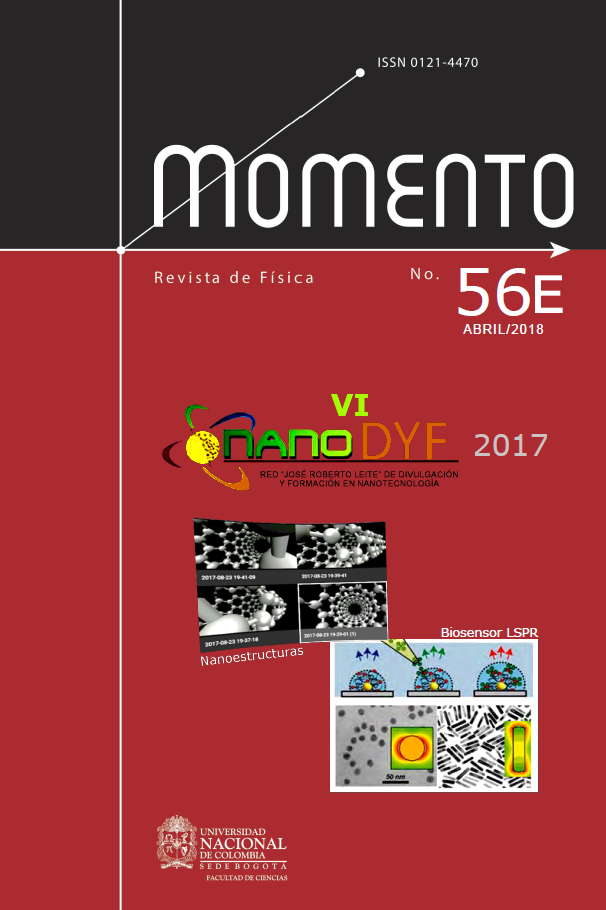LAS NANOCIENCIAS EN UNIVERSIDADES DE ENSEÑANZA DE ARTES LIBERALES: INSERCIÓN CURRICULAR E INTEGRACIÓN DE PLANES DE ESTUDIOS
NANOSCIENCES IN LIBERAL ARTS COLLEGES: CURRICULUM EMBEDDING AND PROGRAM’S INTEGRATION
Keywords:
Programas de estudios, nanociencias, integración disciplinaria, ciencias básicas, ciencias aplicadas, superconductividad, emprendimiento, semilleros. (es)Academic programs, nanosciences, academic integration, STEM, applied science, superconductivity, entrepreneurship. (en)
Downloads
En esta comunicación se presenta una aproximación a la enseñanza de las nanociencias desde la perspectiva de la Facultad de Ciencias de la Universidad de Santo Tomas, cuya enseñanza es en artes liberales, y donde no hay establecida una licenciatura en Física. Así mismo, el programa curricular de otras licenciaturas no deja espacio a un curso directamente asociado con las nanociencias. También tiene como objetivo, despertar en los estudiantes el sentido de emprendimiento tecnológico y mostrar, cómo las ciencias aplicadas pueden conducir a modelos matemáticos que a su vez pudieran ser extendidos a otras ramas de las ciencias básicas. Al tomar de ejemplo el fenómeno de la superconductividad, se muestra, cómo el mismo vincula avances tecnológicos desde la medicina y la ciencia de la computación y se extiende a la astrofísica y la cosmología.
This communication discusses an approach for teaching about nanosciences from the perspective of the School of Sciences at St. Thomas University with a “Liberal Art” type of education, where also there is not a major in Physics neither room within the curriculum for a course on nanosciences. Besides that, this approach intends motivate students about technological entrepreneurship and discuss how applied sciences might be conducive to mathematical models that might be extended to other basic science fields. In this end, the phenomenon of superconductivity is discussed from different angles, and it is shown how it is linked to technological advances from medicine to computer science, and from them to astrophysics and cosmology.
References
J.Beesky, Emerging Health Threats Journal 3, 7098 (2010); C.P. Slade, Minerva 86, 49 – 71 (2011); G.M. Zenner and W.C. Crone, Journal of Nanoparticle Research 9, 183 – 189 (2007); D.A. Scheufele and B.V. Lewestein, Journal of Nanoparticle Research 7, 659 – 667 (2005).
J. Stanton, An introduction to data science, Syracuse University, https://storage2.ischool.syr.edu/media.ischool.syr.edu/oldmedia/documents/2012/3/DataScienceBook1_1.pdf; J.H. Panchal, S.R. Kalidindi, D.L. McDowell, Computer-Aided Design 45, 4 – 25 (2013); D.A.C. Beck, J.M. Carothers, V.R. Subramanian, and J. Pfaendtner, AICheJournal 62, 1402 – 1416 (2016).
Nanotechnology National Initiative, www.nano.gov/education-training/teacher-resources.
Nanotechnologies,
https://ec.europa.eu/research/industrial_technologies/pdf/nano-hands-on-activities_en.pdf.
Guía Didáctica para la Enseñanza de las Nanotecnología en Educación Secundaria, Editores N. Takeuchi, P. Serena, J. Giraldo y J. Tutor, (2004).
K. Srinivas, Nat. Science Journal of Education 2(2), 58 - 64 (2014).
J.V. Ernst, The Journal of Technology Studies 3-6 (2009); G.S. Ahmed, International Journal of Information and Communication Technology Education 8 (3), 55-63 (2012).
D. Chari, P. Irving, R. Howard, and B. Bowe, International Journal of Engineering Education 28 (5), 1046 - 1055 (2012); N.I. Ghattas, J.S. Carver, Research in Science and Technological Education 30 (3), 271-284 (2012).
St. Thomas Factbook, http://web.stu.edu/Portals/0/OIR/FB2015.pdf.
D. Quesada, Momento 54E, 28-37 (2017).
J. Bardeen, L.N. Cooper, J.R. Schrieffer, Phys. Rev. 108, 1175-1204 (1957).
R. Baquero, Rev. Acad. Colomb. Cienc. 38 (Supl.), 18-33 (2014).
M.R. Norman, Rep. Prog. Phys. 79, 074502 (2016); M. Klintenberg and O. Eriksson, Comp. Mat. Sci. 67, 282-286 (2013).
F. Wilczek, Nature 433, 239-247 (2005); E. Witten, in PWA90: A life of emergence, World Scientific, pp 73-89 (2016).
D. Quesada, Int. J. Mod. Phys. B 17, 3559 (2003); D. Quesada, Physica C 364-365, 170 (2001).
D. Quesada, R. Pena, and C. Trallero-Giner, Physica C 322, 169 (1999); R. Baquero, D. Quesada, and C. Trallero-Giner, Physics C 271, 122 (1996).
M.V. Barreat and D. Quesada, In Proceedings of the MOL2NET, International Conference on Multidisciplinary Sciences, Sciforum Electronic Conference Series, Vol. 3, 2017; doi:10.3390/mol2net-03-05100, http://sciforum.net/conference/161/paper/5100.
D. Quesada, J. Cotton, J. Morales, In Proceedings of the MOL2NET, International Conference on Multidisciplinary Sciences, 5 December 2016–25 January 2017; Sciforum Electronic Conference Series, Vol. 2, 2016 ; doi:10.3390/mol2net-02-03834, (2016).
How to Cite
APA
ACM
ACS
ABNT
Chicago
Harvard
IEEE
MLA
Turabian
Vancouver
Download Citation
Article abstract page views
Downloads
License
Copyright (c) 2018 MOMENTO

This work is licensed under a Creative Commons Attribution-NoDerivatives 4.0 International License.
Those authors who have publications with this journal, accept the following terms:
a. The authors will retain their copyright and will guarantee the publication of the first publication of their work, which will be subject to the Attribution-SinDerivar 4.0 International Creative Commons Attribution License that permits redistribution, commercial or non-commercial, As long as the Work circulates intact and unchanged, where it indicates its author and its first publication in this magazine.
b. Authors are encouraged to disseminate their work through the Internet (eg in institutional telematic files or on their website) before and during the sending process, which can produce interesting exchanges and increase appointments of the published work.




















